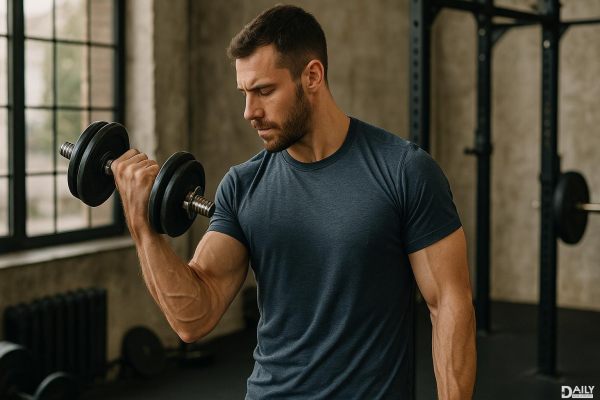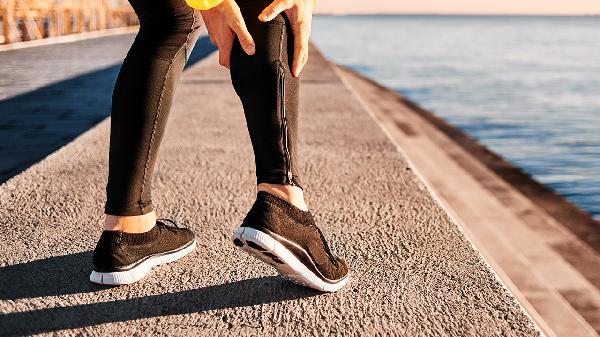Picture this: you just got home from the grocery store and you've got ten bags full of goodies. There is no way you're taking multiple trips to get everything inside. Luckily you don't have to, because you've been working out — and specifically targeting those biceps. So you load your arms, flex your muscles, and carry it all in at once. Sounds convenient, right?
Your biceps are the large muscles that run down the front of your upper arm between the shoulder and the elbow. "Biceps are responsible for flexion and extension of the elbow. So functionally, think of everything that you do that requires bending your elbow — from things like carrying all the groceries from the car in one trip to bringing your coffee to your mouth for the first sip in the morning," says Megan Cloe, Group X instructor and trainer at Bay Club El Segundo and Bay Club Santa Monica.
"Training biceps could help reduce the risk of injury to the elbow joint and potentially help prevent things like tendonitis in the wrist, elbow, and shoulder," Cloe says. If you're not sure where to start though, we've got you covered. While the first move that might come to your mind to train your biceps is a biceps curl, there are plenty of exercises that involve the biceps as a secondary muscle group. "The great thing about biceps, is that even if you don't love biceps curls, you can train biceps in many other compound exercises, like chest presses or push-ups," Cloe says.
Why Biceps Training Matters More Than You Think
Most people associate biceps training with aesthetics—getting those "guns" to pop in a tank top. But the benefits run way deeper than just looking good at the beach. Strong biceps contribute to functional strength that impacts daily activities, from lifting your toddler to rearranging furniture. They also play a crucial stabilizing role in shoulder movements and help prevent overuse injuries in the wrists and elbows—common complaints among desk workers and athletes alike.
Neglecting biceps training can create muscle imbalances that lead to poor posture and increased injury risk. Think about it: when your biceps are weak, other muscles compensate, putting unnecessary strain on joints and connective tissues. This domino effect can manifest as everything from tennis elbow to rotator cuff issues. That's why even if you're focused on big compound lifts, dedicating some attention to targeted biceps work pays off in the long run.
The Science Behind Biceps Growth
Your biceps brachii (the fancy anatomical name) actually consists of two muscle heads—the long head and short head—that work together during elbow flexion and forearm supination (that twisting motion when you turn a doorknob). These muscles respond best to a combination of heavy loads for strength and moderate weights with controlled movements for hypertrophy (muscle growth).
Research shows that biceps activation peaks when your elbows are at about 90 degrees of flexion, which explains why partial range-of-motion exercises can be surprisingly effective. The muscle also benefits from varied grip positions—regular curls target the short head more, while hammer curls emphasize the long head and brachialis (a deeper elbow flexor). This anatomical nuance means your biceps routine should include multiple angles and grip variations for complete development.
Beyond Basic Curls: Creative Biceps Exercises
doing endless sets of biceps curls can get boring fast. The good news? There are countless ways to challenge these muscles without mind-numbing repetition. Try incorporating these underutilized movements into your routine:
- Chin-ups (overhand grip activates biceps more than pull-ups)
For those who hate traditional isolation work, compound exercises like inverted rows or battle ropes provide serious biceps stimulation while working multiple muscle groups simultaneously. Even certain yoga poses (hello, downward dog to chaturanga transitions) can serve as functional biceps training.
Common Biceps Training Mistakes to Avoid
Even seasoned gym-goers make these biceps blunders that sabotage their progress. First up: swinging the weights. That momentum might let you lift heavier, but it takes the work off your biceps and puts strain on your lower back. Keep your elbows pinned to your sides and move only at the elbow joint—imagine you're trying to squeeze a lemon between your bicep and forearm at the top of each curl.
Another frequent error? Overemphasizing the negative (lowering) phase. While controlled eccentrics are great for muscle growth, taking five seconds to lower every rep means you'll fatigue before completing your sets. Aim for a 2-3 second lowering phase—slow enough to maintain tension but fast enough to keep the workout challenging.
Perhaps the biggest mistake is neglecting proper warm-up. Cold tendons and muscles are injury magnets, especially with the high volume many people use for biceps training. Start with light resistance bands or very light dumbbells for 2-3 sets of 15-20 reps before jumping into your working sets.
Programming Your Biceps Workout for Maximum Results
How you structure your biceps training makes all the difference in your results. For beginners, 2-3 sets of 2-3 exercises twice per week provides sufficient stimulus. Intermediate lifters might do 3-4 exercises with 3-4 sets each, while advanced trainees can handle higher volume with techniques like drop sets or supersets.
Timing matters too—hitting biceps at the beginning of your workout when you're fresh yields better activation than tacking them on after exhausting back or chest work. That said, pre-fatiguing them with isolation work before compound lifts can create interesting strength challenges for advanced athletes.
Don't forget about recovery—biceps are relatively small muscles that repair quickly, but still need 48 hours between intense sessions. Signs you're overtraining include persistent elbow discomfort, decreased grip strength, and stalled progress. If you notice these, dial back the volume and focus on quality movement patterns.
Remember, building impressive biceps isn't just about how much you lift—it's about how well you lift. Focus on mind-muscle connection, progressive overload, and consistent effort, and those grocery bags will start feeling lighter in no time.
























